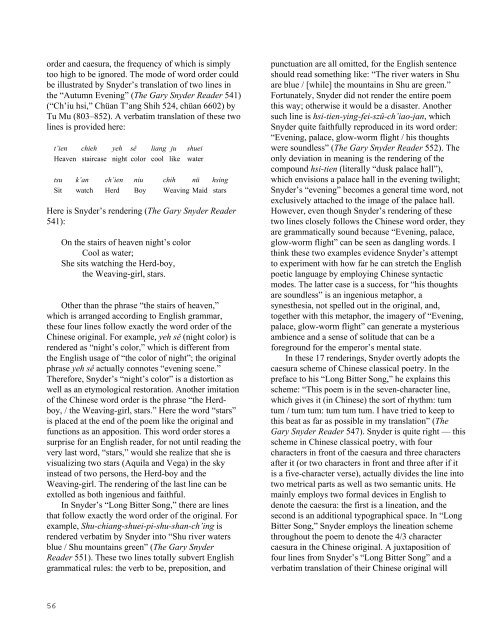their - The University of Texas at Dallas
their - The University of Texas at Dallas
their - The University of Texas at Dallas
Create successful ePaper yourself
Turn your PDF publications into a flip-book with our unique Google optimized e-Paper software.
order and caesura, the frequency <strong>of</strong> which is simply<br />
too high to be ignored. <strong>The</strong> mode <strong>of</strong> word order could<br />
be illustr<strong>at</strong>ed by Snyder’s transl<strong>at</strong>ion <strong>of</strong> two lines in<br />
the “Autumn Evening” (<strong>The</strong> Gary Snyder Reader 541)<br />
(“Ch’iu hsi,” Chüan T’ang Shih 524, chüan 6602) by<br />
Tu Mu (803–852). A verb<strong>at</strong>im transl<strong>at</strong>ion <strong>of</strong> these two<br />
lines is provided here:<br />
t’ien chieh yeh sê liang ju shuei<br />
Heaven staircase night color cool like w<strong>at</strong>er<br />
tsu k’an ch’ien niu chih nü hsing<br />
Sit w<strong>at</strong>ch Herd Boy Weaving Maid stars<br />
Here is Snyder’s rendering (<strong>The</strong> Gary Snyder Reader<br />
541):<br />
On the stairs <strong>of</strong> heaven night’s color<br />
Cool as w<strong>at</strong>er;<br />
She sits w<strong>at</strong>ching the Herd-boy,<br />
the Weaving-girl, stars.<br />
Other than the phrase “the stairs <strong>of</strong> heaven,”<br />
which is arranged according to English grammar,<br />
these four lines follow exactly the word order <strong>of</strong> the<br />
Chinese original. For example, yeh sê (night color) is<br />
rendered as “night’s color,” which is different from<br />
the English usage <strong>of</strong> “the color <strong>of</strong> night”; the original<br />
phrase yeh sê actually connotes “evening scene.”<br />
<strong>The</strong>refore, Snyder’s “night’s color” is a distortion as<br />
well as an etymological restor<strong>at</strong>ion. Another imit<strong>at</strong>ion<br />
<strong>of</strong> the Chinese word order is the phrase “the Herdboy,<br />
/ the Weaving-girl, stars.” Here the word “stars”<br />
is placed <strong>at</strong> the end <strong>of</strong> the poem like the original and<br />
functions as an apposition. This word order stores a<br />
surprise for an English reader, for not until reading the<br />
very last word, “stars,” would she realize th<strong>at</strong> she is<br />
visualizing two stars (Aquila and Vega) in the sky<br />
instead <strong>of</strong> two persons, the Herd-boy and the<br />
Weaving-girl. <strong>The</strong> rendering <strong>of</strong> the last line can be<br />
extolled as both ingenious and faithful.<br />
In Snyder’s “Long Bitter Song,” there are lines<br />
th<strong>at</strong> follow exactly the word order <strong>of</strong> the original. For<br />
example, Shu-chiang-shuei-pi-shu-shan-ch’ing is<br />
rendered verb<strong>at</strong>im by Snyder into “Shu river w<strong>at</strong>ers<br />
blue / Shu mountains green” (<strong>The</strong> Gary Snyder<br />
Reader 551). <strong>The</strong>se two lines totally subvert English<br />
gramm<strong>at</strong>ical rules: the verb to be, preposition, and<br />
punctu<strong>at</strong>ion are all omitted, for the English sentence<br />
should read something like: “<strong>The</strong> river w<strong>at</strong>ers in Shu<br />
are blue / [while] the mountains in Shu are green.”<br />
Fortun<strong>at</strong>ely, Snyder did not render the entire poem<br />
this way; otherwise it would be a disaster. Another<br />
such line is hsi-tien-ying-fei-szû-ch’iao-jan, which<br />
Snyder quite faithfully reproduced in its word order:<br />
“Evening, palace, glow-worm flight / his thoughts<br />
were soundless” (<strong>The</strong> Gary Snyder Reader 552). <strong>The</strong><br />
only devi<strong>at</strong>ion in meaning is the rendering <strong>of</strong> the<br />
compound hsi-tien (literally “dusk palace hall”),<br />
which envisions a palace hall in the evening twilight;<br />
Snyder’s “evening” becomes a general time word, not<br />
exclusively <strong>at</strong>tached to the image <strong>of</strong> the palace hall.<br />
However, even though Snyder’s rendering <strong>of</strong> these<br />
two lines closely follows the Chinese word order, they<br />
are gramm<strong>at</strong>ically sound because “Evening, palace,<br />
glow-worm flight” can be seen as dangling words. I<br />
think these two examples evidence Snyder’s <strong>at</strong>tempt<br />
to experiment with how far he can stretch the English<br />
poetic language by employing Chinese syntactic<br />
modes. <strong>The</strong> l<strong>at</strong>ter case is a success, for “his thoughts<br />
are soundless” is an ingenious metaphor, a<br />
synesthesia, not spelled out in the original, and,<br />
together with this metaphor, the imagery <strong>of</strong> “Evening,<br />
palace, glow-worm flight” can gener<strong>at</strong>e a mysterious<br />
ambience and a sense <strong>of</strong> solitude th<strong>at</strong> can be a<br />
foreground for the emperor’s mental st<strong>at</strong>e.<br />
In these 17 renderings, Snyder overtly adopts the<br />
caesura scheme <strong>of</strong> Chinese classical poetry. In the<br />
preface to his “Long Bitter Song,” he explains this<br />
scheme: “This poem is in the seven-character line,<br />
which gives it (in Chinese) the sort <strong>of</strong> rhythm: tum<br />
tum / tum tum: tum tum tum. I have tried to keep to<br />
this be<strong>at</strong> as far as possible in my transl<strong>at</strong>ion” (<strong>The</strong><br />
Gary Snyder Reader 547). Snyder is quite right — this<br />
scheme in Chinese classical poetry, with four<br />
characters in front <strong>of</strong> the caesura and three characters<br />
after it (or two characters in front and three after if it<br />
is a five-character verse), actually divides the line into<br />
two metrical parts as well as two semantic units. He<br />
mainly employs two formal devices in English to<br />
denote the caesura: the first is a line<strong>at</strong>ion, and the<br />
second is an additional typographical space. In “Long<br />
Bitter Song,” Snyder employs the line<strong>at</strong>ion scheme<br />
throughout the poem to denote the 4/3 character<br />
caesura in the Chinese original. A juxtaposition <strong>of</strong><br />
four lines from Snyder’s “Long Bitter Song” and a<br />
verb<strong>at</strong>im transl<strong>at</strong>ion <strong>of</strong> <strong>their</strong> Chinese original will<br />
56

















